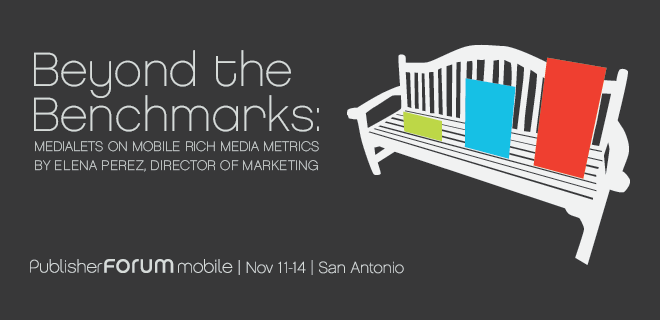
As AdMonsters prepare for our first ever Mobile Publisher Forum (Nov 11-14, San Antonio), we’ve decided to amp up the amount of mobile content delivered on our site. To kick this off, we were able to wrangle an interview with Elena Perez of Medialets to discuss their recent Mobile Rich Media Benchmarks report, which reveals what works and what doesn’t when it comes to rich media on mobile devices. For more on this topic (and many others), stay tuned for the Mobile Publisher Forum!
1. From the Benchmarks Infographic, it seems clear that there are countless data sets to be measured. What are the most important metrics to be measured? Any newcomers? Which, if any, metrics are not as useful on mobile devices as they are in display advertising?
In mobile (like digital) you’ll get performance metrics like Impressions, Clicks and Click-Through. But to effectively measure a rich media ad, you also want to go beyond the basics. In mobile rich media, Engagement Rate is an incredibly valuable metric because it measures whether or not a consumer responded to the call to action within the ad. Expand Rate is a must for Expandable Banners because it indicates the percent of consumers that tapped to view the rest of the creative. Time Spent allows you to measure the length of interaction with an ad unit. It’s a key metric because when you’re working with rich media advertising, you can build an experience that draws users in and holds their attention for a long time. That’s something you want to measure.
Beyond those metrics, we work with customers to establish custom events that measure specific interactions within an ad unit, so you’re not just measuring whether or not they browsed a product catalog and how long, but also what products were viewed most. These actionable insights can go a long way in understanding and optimizing your campaign.
2. Time spent on mobile ads seems to be a big measurement of consumer engagement. What can advertisers do to increase time spent on mobile rich media ads?
As we observed in our Q1 2012 data, Time Spent in mobile rich media is typically around 20 seconds. That’s a meaningful amount of time for a consumer to engage with a brand—comparable to a TV spot, but at a lower cost. But as strong as that performance is, we’re still seeing longer periods on campaigns, sometimes greater than 60 seconds on average. Oftentimes, these campaigns include in-ad games, or video, that draws the user in and holds their attention. Sometimes it’s as simple as offering multiple opportunities for engagement within one ad unit, like multiple videos and an image gallery.
3. The Benchmarks Infographic highlights expandable ad formats, and the expand rate seems to be a good measure of consumer engagement. How does this vary across devices, operating systems, and app/mobile web? Anything interesting to note?
The average Expand Rate, based on our Q1 2012 data, was 1.4%. It’s an impressive number – particularly when you hold it up against the typical .01% CTR of online campaigns. We also explored how the ad format performed across different environments, mobile web versus mobile app, handset and tablet. What was interesting is that Expand Rate remains strong across the board.
4. “In Q1 2011, only 20% of the ads we benchmarked ran across multiple environments (handsets, tablets, mobile web and apps, Android and iOS) but in Q1 2012, that number doubled to 40%.” What does this staggering increase in ads running across multiple environments tell us?
The earlier days of mobile rich media focused largely on iPhone ads because the iPhone provided both the rich capabilities and market share. Even as Android came up quickly (growing 4x as quickly as iPhone, according to Mary Meeker’s latest Industry Trends report), top brands and agencies still leaned on iPhone or iPad, because that’s where the premium publishers were investing and also because it was perceived as just too difficult to navigate cross-platform media buys, specs, delivery and measurement.
As the benchmarks study showed, that’s changing. Medialets is increasingly working with customers who approach mobile as a whole, instead of zeroing in iPhone or even iPad. Medialets is supporting this by addressing the parts of the process – planning, buying, creating, delivering and measuring – that would otherwise become unwieldy for cross-platform campaigns. We’re working hard so that brands, agencies and publishers can get the most out of mobile and skip the headaches.
5. What impact does video have on ad performance?
Our data shows that rich media ads that include video deliver higher Engagement Rates – on average 35% higher – than those ads that don’t. It’s a notable increase and demonstrative of just how much consumers are drawn to video. Of course, because so many brands already have existing video assets, it’s also a logical ingredient for campaigns.
6. How does video usage in ads vary across devices, and what does this reflect? Are consumers more engaged with videos on tablets?
Advertisers are incorporating video into smartphone and tablet ads, but more frequently in tablets. It’s not hard to guess why; the larger screen size is conducive to video consumption. In fact, comScore just shared a study that found that tablet users were nearly three times more likely to watch video on their device compared to smartphone users, with 1 in every 10 tablet users viewing video content almost daily on their device. It’s not surprising, then, that tablet advertisements are twice as likely to include video compared to smartphone ads.
7. Does Medialets have any suggestions for those seeking to run mobile rich media campaigns (advertisers, agencies, or publishers)?
At Medialets, we’ve had the opportunity to enable premium handset and tablet rich media campaigns for many of the world’s leading brands, agencies and publishers. And while we’ve seen success influenced by many factors, there are key practices that brands, agencies and publishers should keep in mind. First, approach mobile early on in a campaign strategy so you can get the most out of its capabilities. In many ways, mobile can operate as the common thread that brings together and empowers other media channels. You lose that added value by treating mobile as an afterthought. Second, define your key performance indicators early on in the campaign – as early as possible – so you can take full advantage of the available metrics. Mobile rich media gives you the ability to tell detailed and meaningful success stories, you don’t want to miss out on that.
 |
With Publisher Forum: Mobile, we’re zooming in on the evolving landscape that is changing the shape of media more every day. Sample topics include the strategic role of Ad Operations on the mobile front, mobile audience targeting and tracking, yield, revenue and inventory management, fragmentation, organizational structure, data monetization and creative executions. Register today for Publisher Forum: Mobile, which will be held November 11-14th. |